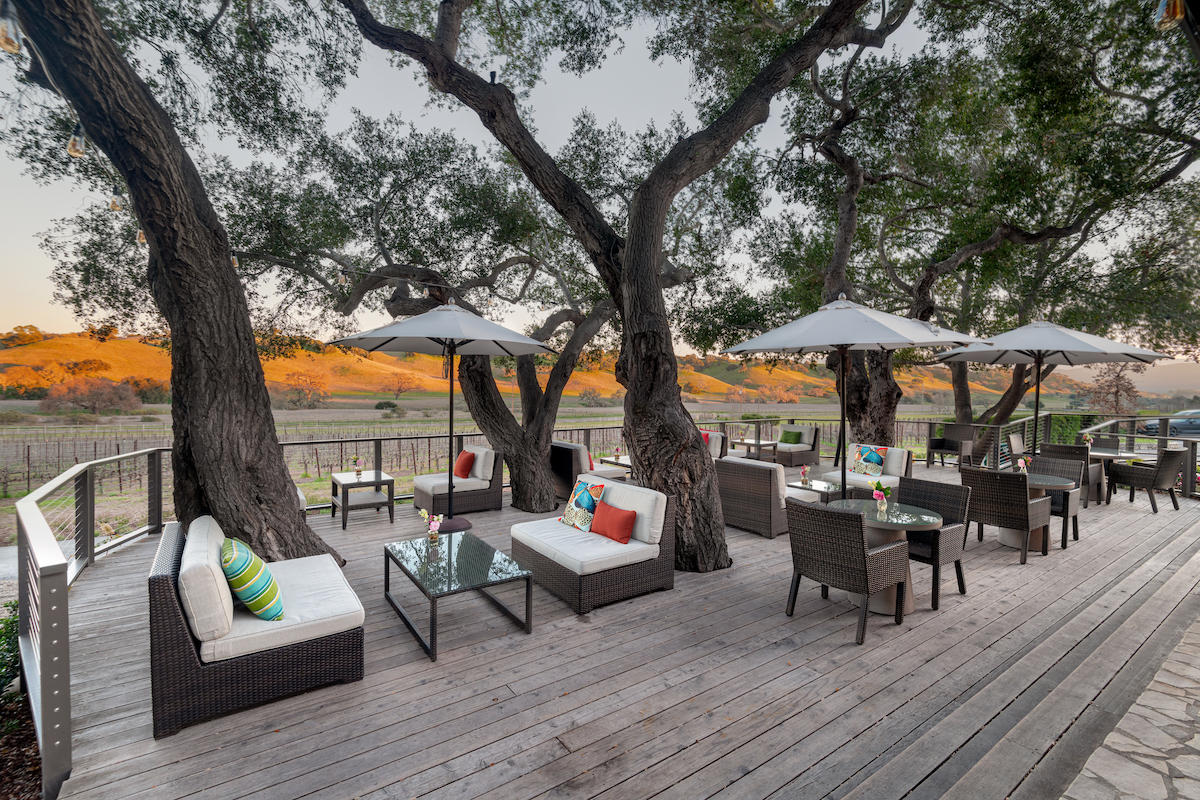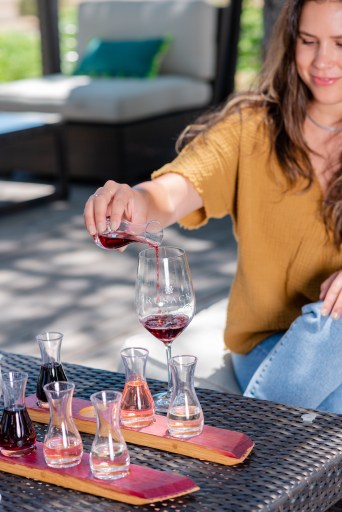Improvements and Inventions at Rusack Winery
Ballard Canyon Estate Remodels Tasting Room and Develops New Grape Varieties

Ballard Canyon Estate Remodels Tasting Room and Develops New Grape Varieties

There’s something for wine fans of all types to dig into at Rusack Winery right now. For those simply looking to enjoy good company in a great setting over excellent sips, the winery just redeveloped its tasting experience to fully embrace the bucolic scenes of Ballard Canyon, offering oak-shaded views of vines, rolling hills, grazing livestock, and roaming wildlife. For those ready to geek out on winemaking techniques, viticultural experiments, and even the promise of brand-new grape varieties, Rusack is ripe for a return as well.
Let’s start at the beginning, which these days involves confirming your reservation at the gate, pulling into a welcome glass of rosé, and settling into your private table on the terrace or deck. This is a stark change from what the visitor experience had become over the 27 years since Geoff and Alison Rusack founded the brand. Like many Santa Ynez Valley wineries that came of age during the 1990s, the tasting room had morphed into more of a tavern-like experience, with folks standing three deep at the bar, angling for their next sip.

“This deck is the coolest deck in Ballard Canyon, and let’s make it feel that way for everybody,” explains winemaker Steve Gerbac, who’s been with the Rusacks since 2003 and guided the redesign. “Let’s connect people to the vineyard. That’s why we’re here.”
Once seated, you choose from a number of flights, exploring the estate wines, or the ones grown on Catalina Island, or the Burgundian varieties they source from around the country. Or create your very own flight, choosing two-ounce pours (or glasses or bottles) from Rusack’s more than two dozen wines, including $100-plus bottlings and select older vintages.
“You can choose from just about every wine we make, as many as you want,” said Gerbac. “We’re not afraid to open anything. No one’s gonna get in trouble.”
This new style of a seated, more intimate, and less formulaic tasting experience is sweeping the industry in our post-COVID era. Wineries see them as a way to better connect meaningfully with customers, which leads to larger purchases and longer wine club relationships. Consumers, meanwhile, are seeking situations that are more refined and private, yet less overtly educational or dogmatic in structure.
Sign up to get Matt Kettmann’s Full Belly Files, which serves up multiple courses of food & drink coverage every Friday, going off-menu from our regularly published content to deliver tasty nuggets of restaurant, recipe, and refreshment wisdom to your inbox
“When someone says, ‘I’m not a big fan of chardonnay,’ we won’t say, ‘Here’s three chardonnays to taste,’ or hand them sauvignon blanc when they say they like chardonnay,” explained second-generation vintner Austin Rusack of this choose-your-own-adventure reality. His team is taking some leads from brewery experiences, where each taste comes with a couple of comments about the beer and that’s it.
“If I need to know more, I’ll ask,” said Gerbac. “Instead, I talk about the oak trees and why they look the way they do. I talk about the goats across the street, the last ones from Catalina Island.”
Of course, with more than two decades of winemaking under his belt, Gerbac could certainly talk forever about the wines, from the famed estate syrah to those ever-imperiled Catalina vines that seem to face a new malady each vintage to the experimental nursery that he’s developed on a ranch just to the north of the tasting room. Called Rancho Colina, this was the home to those early shoots of zinfandel that Geoff Rusack pulled from Santa Cruz Island years ago for the Catalina Island project. Gerbac is steadily expanding the plantings, now with mission grape, alicante bouschet, varying rootstocks, and some still-unknown vines in the ground.
A few years ago, when a nursery order didn’t come in as expected, Gerbac decided to plant 1,000 of those island zinfandel grape seeds in the ground to see what happened. Like for many crops, grape seeds don’t grow into the same grape as the parent, and most simply fail, at least from commercial standards.

“I had grapevines with white leaves,” confirmed Gerbac, who culled the weird and weak ones while saving the stronger vines. One was a white grape, even though it came from red zinfandel, so he had that tested by UC-Davis, which confirmed that he’d raised a brand new grape unknown to science.
“It took me a couple years to figure out what I’d done,” admitted Gerbac, who said the variety’s acidity is perfectly in line with its sugar levels at harvest. He and the Rusacks are now seeking to commercialize the grape, which is still unnamed. “Colina blanc” was my suggestion and “chardonnel” was also under consideration, but “white zinfandel” is certainly out.
That sort of jabber can keep wine geeks going for hours, but we’re not a high percentage of any tasting-room crowd. Gerbac knows that better than anyone. While plotting the tasting room redo even prior to COVID, he’d sit anonymously on the patio and eavesdrop. Very few people were focused on the wine itself — it was all about the place, the vibe, the company, the moment.
“I wish everyone couldn’t stop talking about the wines I make, but this is why people are out here,” said Gerbac of the scene he’s cultivated. “We don’t need 200 people in here every day like we used to have. But if we could get 50 that actually remember us, that feels like the right way to go.”
1819 Ballard Canyon Rd., Solvang; (805) 688-1278; rusack.com
Rusack Wines to Try
Icon Sauvignon Blanc & Syrah: This top-tier line, which started in 2016, features wines with more age, oak, and concentration. The top two barrels of musque clone sauv blanc are fermented in new oak and then kept there for an extra six months to soften out the edges. “There’s something about the musque clone and oak — it lifts those aromatics,” said Gerbac. “This is what the grapes taste like when I pick them.” The $125 syrah amplifies the acclaim that Ballard Canyon gets for the grape, but you can get a taste here for just $8.
Catalina Island Chardonnay: “There’s so much acidity,” said Gerbac of these island wines, which they planted in precarious conditions 15 years ago. Even the 2015 is still loaded with zip that cuts through the nutty core.
Anacapa: The 2018 blend of Vogelzang Vineyard cabernet with the estate’s petite verdot and merlot is full of tobacco and dried pepper notes. “This is the style of cab we like,” said Gerbac. “It’s not sweet.” Added Rusack, “I love that hint of green in there.”
Support the Santa Barbara Independent through a long-term or a single contribution.
Please note this login is to submit events or press releases. Use this page here to login for your Independent subscription
Not a member? Sign up here.
You must be logged in to post a comment.